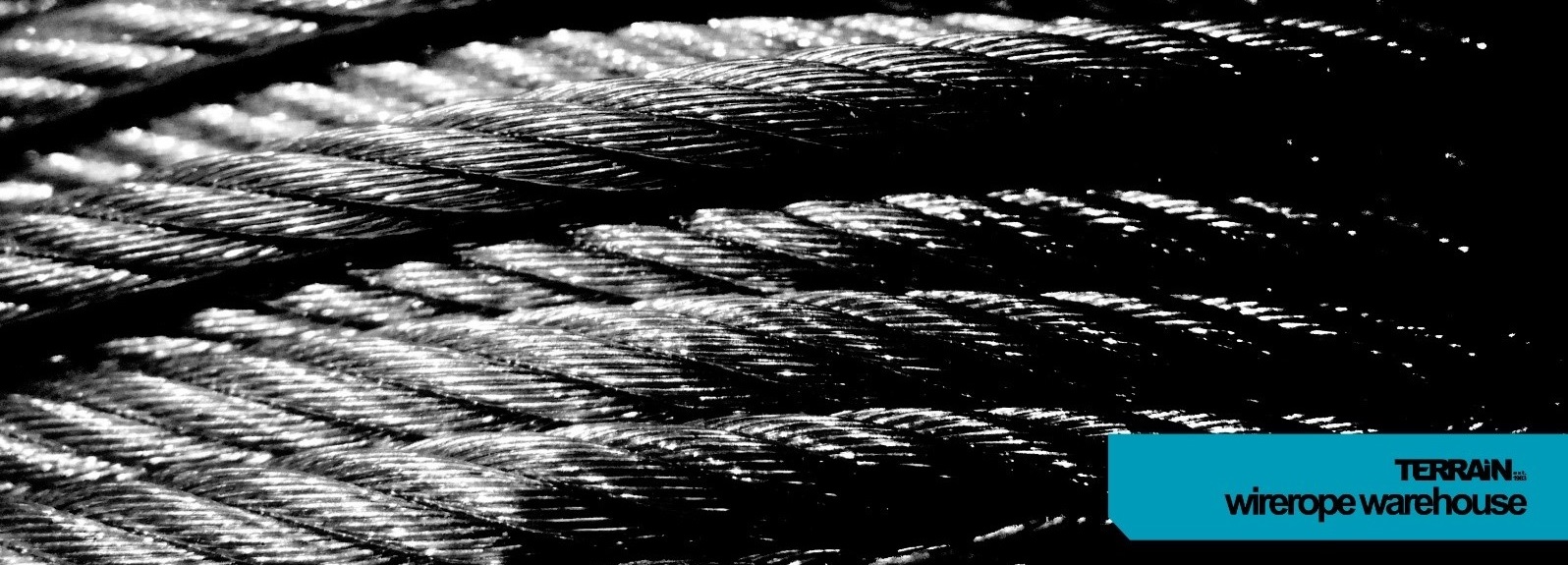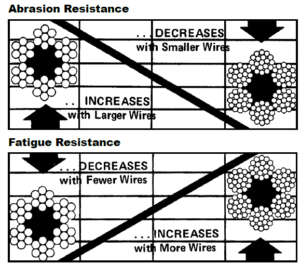
WIRE ROPE IN FORESTRY: FINDING WHAT WORKS
Gidday again everyone, Dale here @ TERRAIN. I hope everyone is enjoying the festive season and you’re all ready for Christmas just around the corner. Before we get into our latest topic on wire rope in forestry, make sure to catch our last post on our own story here. Coming right up, I explain why TERRAIN recommends our KISWIRE 6×26 IWRC and not 6×31. If you’re running a swing yarder in your block you’ll be blown away by our swaged 22mm (7/8”) 6×26 KISWIRE wire rope and its longevity. Give us a buzz if you’re interested here.
THE BASICS
I’ll keep the intro brief as there’s a lot of blogs out there on wire rope construction already. Wire rope is a cable made up of a number of strands that are composed of many smaller wires and a core. It was, at least according to Wikipedia, created by a German bloke in the middle of the 1800s for building bridges. He came up with the idea as it lasted far longer than fibre rope.
Today, your wire rope can come in all sorts of sizes, constructions and lays; all with varying cores. Our wire rope manufacturer, KISWIRE has a really great cross-section of the various constructions here. Burgen Cable, on their CABLE 101 PAGE, breakdown a few options: from 1 strand of 7 wires (1×7) to 7 strands of 19 wires (7×19).
You’ll also find a variety of lays in how these wires and strands are placed during construction. Hanes Supply have a good visual piece of the various lays. Right hand, regular lay will be what you primarily find in NZ as it has the most versatility. However, Lang’s lay can provide greater flexibility; however, there’s a cost of increased abrasion over small sheaves or winding onto drums. Wire rope comes with 2 primary types of cores: Either a fibre core or an Independent Wire Rope Core (IWRC). Fiber cores generally provide more fatigue resistance and elasticity, whereas IWRC cores provide much better crush resistance.
INTO THE FOREST
In order to apply the construction of wire rope in forestry, we need to first cover the some of the reasons wire rope fails on the job.
Abrasion
Abrasion (or metal loss) is the wearing of the metal on the outside of your rope. One cause of abrasion is the metal on metal wear from the rider blocks and carriages. These blocks can move out up to 1KM with each drag. Rope wrap is another condition wire rope in forestry faces (and everyone faces it). Rope wrap occurs in swing yarders when the tail rope wraps around itself between the grapple and the back-line machine. Towers face it at the tower sheaves.
If the only condition you were facing was rope abrasion, you would want fewer and thicker wires for more resistance. However, as you increase your wire size and decrease the number of strands you decrease the flexibility of your rope—think of moving towards a single, solid piece of steel. Bill Teichgraber (a wire rope & rigging trainer) has a great article on what abrasion looks like here:
Crush Damage
According to Safetree in their Cable Logging Guide: Crush damage exists in forestry due to a few conditions present on the drums, either loose spooling or any poor fleeting, leading to cross over on the drum. Here’s a great time to plug our wire rope installation truck too. Let us help wind your new tail in under pressure for the best drum lay. Find out more here.
The best way to combat crush damage is to have a steel core (formally known as IWRC). The core prevents the makeup of the rope from changing, which impacts the wire ropes strength. Additionally, fewer strands can also help, so stick to 6 strands rather than 8. Thankfully, these technologies are largely already present throughout wire rope in forestry.
Fatigue Damage
Rope fatigue, or bend fatigue as covered by SAFETREE, is caused because of high tension on the pull. Because logs can sometimes be fully suspended rather than a partially suspended or ground lead drag, swing yarders put this higher tension on the tail rope. This tension is a particular issue if the tail runs tightly around the sheaves that are too small at the back-line holding machine. Bending fatigue also occurs in any event where the rope is switching sharply in opposite directions (reverse bending).
Should fatigue damage be all you were facing, you would want a wire rope with many smaller wires. Think of moving towards a length of fibre rope with many many individual fibres: very flexible and would handle tight corners well, but would not stand up to the damage a rope receives over the day to day in the bush.
WHAT ELSE HAS CHANGED?
Now I have covered the conditions facing wire rope in forestry, I want to mention the changes we’ve seen in the cable yarding environment over the years.
I’ve mentioned previously we’ve seen more swing yarders in NZ over the last 10 years. Pole hauler’s, with the use of its skyline, will quite happily fully suspend its drag; however, it’s not recommended for a swing yarder. It’s not always possible to eliminate all cases of full suspension, though, so the tail takes more of a beating here too.
Additionally, in order to meet the targets that seem to be ever on the rise, everyone’s putting more and more pressure on their wire ropes–pulling more and more wood each drag. Concepts like pre-bunching are meaning that not only are multiple stem drags more common but as the grapples are getting bigger to compensate – it’s all more and more tension on the tail.You’ll find the speed of each drag is going up too, as that tail winds ever fast around the blocks.
THE TRADE-OFF
When selecting the right wire rope in forestry, we need to consider the trade-off between abrasion resistance and larger wires (i.e. 6×19); and fatigue resistant and smaller wires (i.e. 6 x 31). I like the graphic from Mazzella to show what I mean:
It’s like what UNION Wire Rope have to say: in their guide to choosing the right rope:
“All wire ropes feature design property trade offs. In most cases, a wire rope cannot increase both fatigue resistance and abrasion resistance. For example, when you increase fatigue resistance by selecting a rope with more wires, the rope will have less abrasion resistance because of its greater number of smaller outer wires.”
TERRAIN’S GOT THE ANSWER
Firstly, I have to address the elephant in the room with the discussion around wire rope in forestry. 6 x 31 has been shown as NOT EFFICIENT SPEND for your wire rope. As discussed above, the smaller wires just cannot stand up the conditions of today’s forestry environment. Sure, it is flexible but it simply cannot handle the abrasion present in a swingers rider blocks and back-line holding machine as well as the obstacles present in a pole haulers tail rope setup. Instead, we strongly recommend our KISWIRE 6 x 26 IWRC as a PROVEN wire rope in forestry. 6 x 26 is the best compromise to handle the fatigue issues as well as standing up the all of the abrasion and crush damage present in the bush.
But our answer doesn’t stop here. If you really want to extend the life of your wire ropes in forestry you need to consider using bigger blocks. SAFETREE’s cable logging guide says the following: “The diameter of the sheave should be 20 times the rope diameter. This is not always practicable, but if smaller diameters are used rope life may be shortened”. To this end, follow our customers in extending the life of their tails with our 518 blocks complete with 18” sheaves. We’ve got all the information on these blocks here
THAT’S A WRAP
Well, there’s the end. Appreciate everyone who stayed until the end. Remember, TERRAIN is always here for advice and a chat 24/7. Contact us by phone on: (07) 378 47 54 or 027 258 9060, you can find us on Linkedin now too. Or you could always email me at [email protected] and we’ll be more than happy to help.
Cheers,
Dale.




